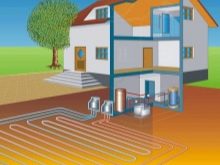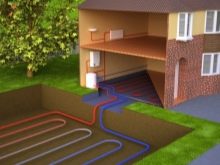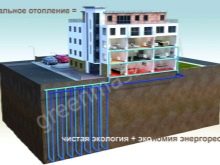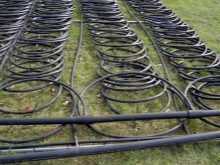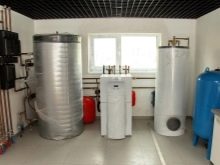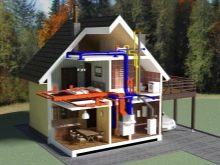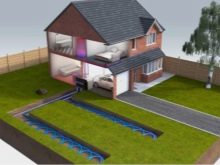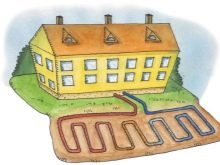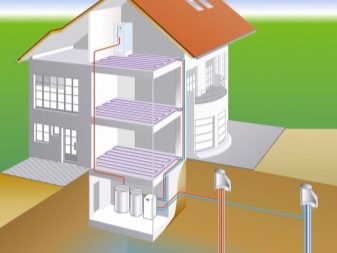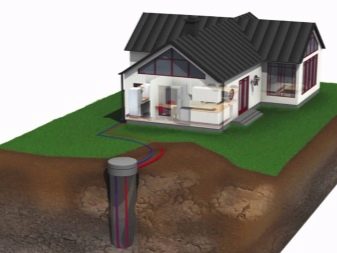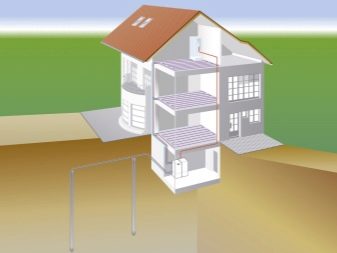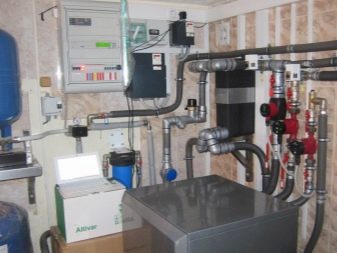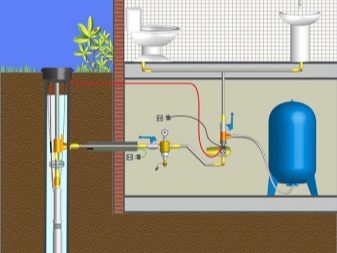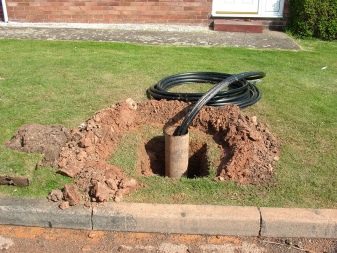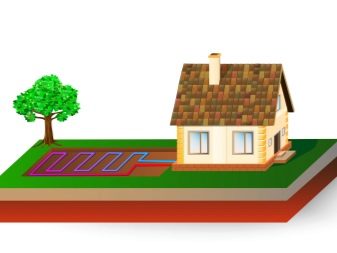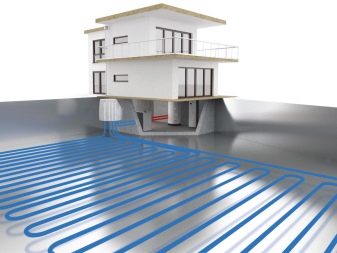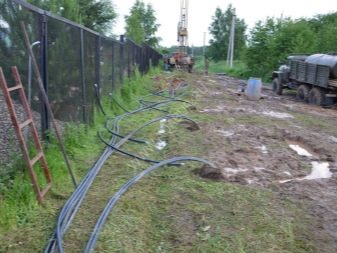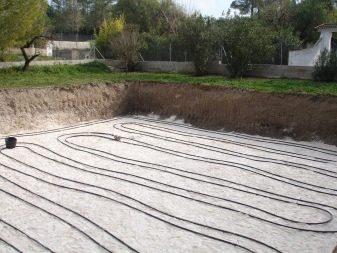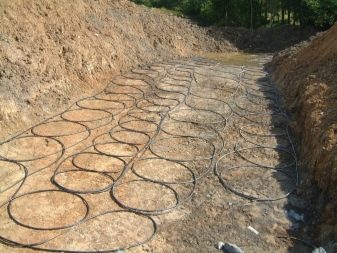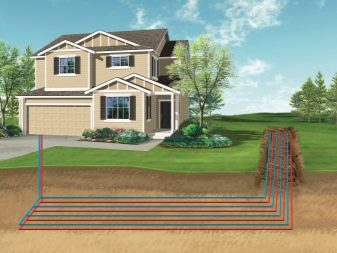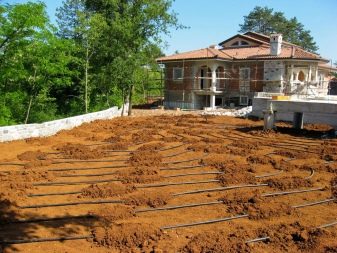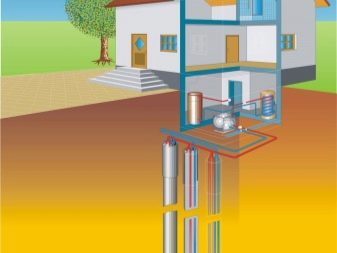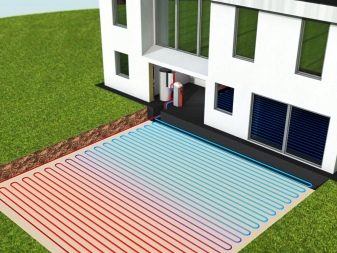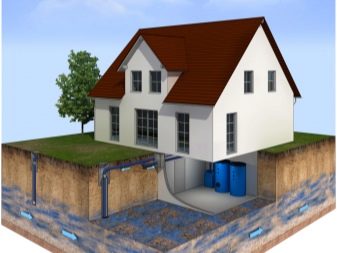Geothermal heating: the principle of operation, the pros and cons, the subtleties of construction
There are many different options for heating homes. People's attention is naturally focused on finding ways that consume the least energy. Fierce disputes are caused by such a progressive method of obtaining heat, as the use of underground sources.
How does it work?
The principle of geothermal heating involves the use of heat pumps. They operate according to the classical Carnot cycle, taking a cold coolant deep below and receiving in return a flow of liquid heated to 50 degrees inside the heating system. The equipment works with efficiency from 350 to 450% (this does not contradict the fundamental physical laws, why - it will be said later).A standard heat pump heats a house or other building due to the heat of the earth over 100 thousand hours (this is the average interval between preventive overhauls).
Heating up to 50 degrees is not accidental. According to the results of special calculations and in the study of practically implemented systems, this indicator was recognized as the most effective. Therefore, ground heating, which uses the flow of energy from the depths, is mainly supplemented not by radiators, but by a warm floor or air circuit. On average, per 1000 W of energy, which drives the pump, it is possible to raise upwards of about 3500 W of thermal energy. Against the background of the rampant rise in the cost of the coolant in the main network and other heating methods, this is a very pleasant indicator.
Geothermal heating is formed by three circuits:
- ground collector;
- heat pump;
- in fact, a heating complex at home.
A collector is a collection of pipes, which are supplemented with a pump for recycling. The coolant in the external circuit has a temperature of from 3 to 7 degrees. And even such a small outward scatter allows the system to effectively solve the tasks.For heat transfer, either pure ethylene glycol or its mixture with water is used. Fully water circuits underground heating are rare.
The reason is simple - the water that is found in a sufficiently heated layer of soil quickly erodes the equipment. And even such a liquid can be found not in any arbitrarily taken place. The choice of a specific coolant is determined by the design decisions of engineers. The pump is selected depending on the device the remaining parts of the system. Since the depth of the well (the level of the equipment) is determined by natural conditions, the decisive differences between the types of geothermal systems are associated with the device of the reservoir in the ground.
The horizontal structure implies the location of the collector under the line of soil freezing. Depending on the specific location, this means a deepening of 150-200 cm. Such collectors can be equipped with various pipes, such as copper (with an external layer of PVC) and made of metal-plastic. To get from 7 to 9 kW of heat, you will have to lay at least 300 square meters. m collector. This technique does not allow to approach the trees by more than 150 cm, and upon completion of the installation it is necessary to improve the territory.
A vertically exposed reservoir implies the drilling of several wells, and necessarily directed in different directions, and each lead from its own angle. Inside the wells are geothermal probes, the thermal return from 1 running. m reaches about 50 watts. It is easy to calculate that for an identical amount of heat (7-9 kW), 150-200 m of wells will have to be supplied. The advantage in this case is not only in economy, but also in the fact that the landscape structure of the territory does not change. It will only be necessary to allocate a small area for the installation of the caisson unit and for placing a concentrating collector.
A contour heated from water is practical if it is possible to bring an external heat exchange unit into a lake or pond to a depth of 200 to 300 cm. But the prerequisite will be the location of the reservoir within a radius of 0.1 km from the heated building and the water surface area of at least 200 square meters. m. There are also air heat exchangers when heat is generated by an external circuit from the atmosphere. Such a decision perfectly manifests itself in the southern regions of the country and does not require any excavation work. The weakness of the system is low efficiency with a frost of 15 degrees and a full stop if the temperature drops to 20 degrees.
Special features
Geothermal heating of a country house, first of all, does not consume expensive and polluting air mineral fuel. Already 7 of the 10 new houses built in Sweden are heated in this way. On hot days, geothermal equipment from a heater becomes a means of passive conditioning. Contrary to popular belief, such a heating system does not need volcanoes or geysers. In the most ordinary flat terrain, it acts no worse.
The only condition is to reach the point below the freezing line by the thermal contour.where the temperature of the soil is always from 3 to 15 degrees. Ultra high efficiency only seems to contradict the laws of nature; the heat pump is saturated with freon, which evaporates under the action of even “ice” water that seems to people. Steam warms the third circuit. Such a scheme is a refrigerator turned inside out. Therefore, pump efficiency refers only to the quantitative ratio of electrical energy and thermal resources. By itself, the drive is “as it should be,” with inevitable loss of energy.
Advantages and disadvantages
Objective advantages of geothermal heating can be considered:
- excellent efficiency;
- a solid period of service (a heat pump has operated for 2-3 decades, and geological probes are up to 100 years old);
- stability of work under almost any conditions;
- lack of binding to energy carriers;
- full autonomy.
There is one serious problem that makes geothermal heating a really common solution. This, as shown by the reviews of the owners, the high price of the created design. To warm the usual house of 200 square meters. m (not so rare), it will be necessary to build a turnkey system for 1 million rubles, up to 1/3 of this amount is a heat pump. Automated installations are very comfortable, and if everything is set up correctly, they can work for years without the intervention of people. Everything depends only on the availability of funds. Another disadvantage is the dependence on the power supply of the pumping unit.
The risk of ignition of a geothermal heating system is zero. You should not be afraid of occupying it with unnecessary space; in the house itself the necessary parts will require approximately the same area as an ordinary washing machine.Moreover, space is released, which usually has to be allocated for fuel supplies. Personally build the necessary contours is unlikely to succeed. Designing is also better to entrust to professionals, since the slightest mistake can lead to unpleasant consequences.
Arrangement
Quite a few people are trying to create geothermal heating with their own hands. But in order for such a system to work, careful calculations must be made, and the layout of the pipe wiring is also required. It is impossible to bring the well closer to the house by more than 2-3 meters. The maximum permissible drilling depth reaches 200 m, however, wells reaching a good 50 km show good efficiency.
Calculations
The main parameters that are taken into account in any calculations are:
- temperature (depth from 15-20 m and more warms up from 8 to 100 degrees depending on the conditions created);
- the value of recoverable power (average - 0.05 kW per 1 m);
- influence of climate, humidity and contact with groundwater on heat transfer.
What is very interesting, completely dry rocks give no more than 25 W with 1 mand if there is groundwater, this figure rises to 100-110 watts. We must not forget that the standard operating time of the heat pump is 1800 hours per year.If this indicator is exceeded, the system will not become more efficient, but its wear will grow rapidly. What is much worse, over-exploitation of the thermal resource of the subsoil leads to their cooling and even to freezing of rocks at the working depth. Following this, soil can sink, sometimes working pipes and above-ground structures are damaged.
It is necessary to carefully calculate the actions for the regeneration of soil properties. Only by supplying heat to the well periodically, instead of extracting it outside, can the system be guaranteed stable for many years to come. How often to do it and what else to do - it will prompt just the calculations made by experienced designers. The payback time of geothermal heating, even with the highest efficiency, is at least 10 years. So besides the engineering aspects, you should carefully consider the economics of the project.
Sequence of work
Heat supply at the expense of underground sources should be created according to a strictly developed algorithm. Since water and air systems are limited, most of the practical options involve drilling wells.And this is another reason for not doing everything with your own hands. Only special equipment allows to penetrate to a depth of 20-100 m, where the necessary conditions for heating are created. The use of plastic pipes designed for a pressure of about 6 bar is allowed as probes.
To improve the performance of the system, use strapping of 3 or 4 linesThe end sections of which are connected in the form of the letter U. Heating along the contour is very important, thanks to it, the cracking of pipes during severe frost is eliminated. This heating is carried out through a wire stretched to the center of the channel, through which current is applied. If energy piles cannot be applied, horizontal receivers must be used. A platform with dimensions of 15x15 m is being prepared for them, and soil is removed from it to a depth of up to 0.5 m.
This whole area is needed for laying similar probes. Electrical mats or pipes that exchange heat are often used. To improve the efficiency of the heating system, apply the layout of the pipe in a spiral or in the form of a "snake". It is impossible to say exactly what is better - ready-made complexes, mass-produced, or self-assembly.In the first case, the compatibility problem is solved automatically, but in the second, flexibility increases, the potential for modernization increases (although more attention should be paid to design).
Amateur builders can get away from a typical heat accumulator, replacing it with a concrete screed. Geothermal heating in such a system eliminates the need for significant temperature jerks. It is possible to conduct experiments with different heat transfer fluids, as well as to mount compressors with varying capacity. By calculating the load properly and correctly distributing the heat along the consuming circuits, you can make the system more efficient by 15-20%. In parallel, the cost of power is significantly reduced.
Horizontally placed pipes are laid to a depth of 50-300 cm. To the area of highways was the smallest, they are made in the form of turns. But between the individual two highways should be at least 200 mm. Any construction work must be preceded by a determination of the thermal return of the soil. If it is less than 20 watts per 1 square. m, there is no point in the geothermal contour. To ensure the discharge of groundwater, the bottom of the pits is covered with a layer of sand.Pipes based on cross-linked polyethylene work well.
Recommendations for use
The most efficient operation of the heat pump is provided in rooms where the air temperature is between 14 degrees Celsius. Whenever possible, you should prefer vertical alignment of contours to horizontal, because it is the most efficient of all. Judging by the reviews, in its pure form, geothermal heating is irrational, it warms the water for too long, because in many cases such a system performs a purely auxiliary role. To achieve the highest performance, you should focus on the maximum allowable intensity of the involvement of the thermal resource and the estimated flow rates of the well.
If the bottom is not dry rocks, and hot water, this is almost the optimal situation. Then it is possible to save money and get the maximum benefit. But we must remember that if it is planned to simultaneously use hot underground sources for water supply, the water in them must meet the standard sanitary requirements. When chemical analysis shows the presence of aggressive components, it is advisable to organize two autonomous circuits, in which the liquid does not mix, but only the exchange of heat occurs.Compressors are fixed on the walls either from refrigerators or air conditioners.
If the house wiring is rather weak, it is worthwhile to use a pair of compressors to reduce the starting current due to the series connection. At installation of condensers it is necessary to take care of the movement of freon in them from the top point to the bottom, and not vice versa. In order for the collector to work stably and heat the room, its area (for a private house of 100 sq. M) must be 200-250 m2. Horizontal heating scheme should not be used if you plan to subsequently split the garden or vegetable garden. Even a conventional borehole pump can be used to complete the system.
About what geothermal heating is and how to install it, see the following video.



